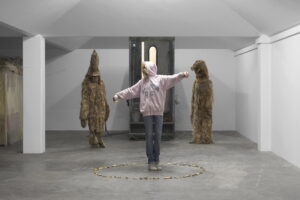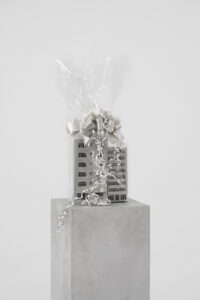Under a landscaped lake at Kay Fiskers Plads, right next to Ørestad metro station, contemporary art has gone underground. In the 1.300 m2 concrete space, which was originally built for bicycle parking, the exhibition site SIMIAN is housed.
SIMIAN, who are among the nominees for BKF prize Artist-run Exhibition Places of the Year, is initiated and run by visual artists Markus von Platen, Christian Vindelev, Toke Flyvholm and Jan S. Hansen. Here they collectively answer BKF's question about the new, underground meeting point for contemporary art in Ørestad.
"Simian opened in September 2020, but we have been working on realizing the place since 2016. The motivation has always been to investigate the edges of the contemporary art field through exhibitions with Danish and international artists."
"We work closely with the exhibiting artists to jointly develop their ideas and visions. For some, the relatively large exhibition space is an untested format, while others are more experienced in realizing large-scale projects. It is a very diverse and dynamic process, which is also part of the driving force that makes us invest so much energy in the project.”

SIGNA – The Market. Photo: Brian Kure / GRAYSC. SIMIAN 2021.
"The collaboration with the artists is, on the whole, very rewarding; a special collective spirit arises in the work of creating the exhibitions and everything that goes with it.”
An example is the latest exhibition with the performance group SIGNA, who have used Simian's workshop for several months leading up to the exhibition.
"We have followed and participated in the process from idea to realization, and have therefore gained a very close insight into their way of working."
Incubators in the art ecosystem
Simian's first exhibition, the group exhibition Some of the Hole, was a bit of a baptism of fire, say the exhibition venue's four founders.
"With the participation of 15 artists, the majority of whom were from abroad and some from outside the EU, we had to learn a lot about import rules and international art transport. The exhibition was an introduction for us to how to manage a lot of the work, which is a large part of the process of gathering the threads in an exhibition project.”
"Some of the Hole dealt with various coincidences between psychological mechanisms and architecture, specifically in relation to Ørestad as a district. Since Simian's location in Ørestad has a great deal of significance for the experience of visiting the place, we think it was obvious to let the exhibition program begin with this reference to the local area."

Some of the Hole, Ghislaine Leung, Company, 2019. Photo: GRAYSC.
In your view, what role do artists' self-organized projects play in art life - and in society?
“Independent exhibition venues play an indispensable role in the art world ecosystem. Often as a kind of incubator or development space for a more unfiltered form of expression. Many exhibition venues function as meeting points for extended circles of acquaintances or groupings of artists. In this way, most places operate in the artists' own environments and networks, where practice and identity are produced and exchanged simultaneously. For the public, it is an opportunity to experience art in its most budding form, and access to a space where the dialogue about the essence of art is an integral part of the experience.”
Focus on the self-organized field
Self-organized exhibition venues come in many different designs, and with very different starting points and ambitions, state the people behind SIMIAN.
"But what most of them have in common is that they have a different agenda than the established institutions and commercial galleries. There is often a distinct personal commitment and a desire to approach the art on its own terms.”
If you had to name 1 thing that could improve the conditions for artist-run places, what would it be?
"It is difficult to avoid the question of finances when talking about the challenges for the artist-run places. And the debate about artists' conditions and precarious working conditions, which takes up more space now than a few years ago, is of course really important. In addition, one could wish that the established media would orientate themselves a little deeper and wider, so that e.g. it was not only the exhibitions of the established institutions that were reviewed and debated. Especially in Copenhagen's self-organized art scene, there is a lot going on that deserves more publicity and interest."
This invitation is hereby passed on - stay tuned www.bkf.dk/kunstnerdrevne over the summer, where we will mention several of the nominees for the BKF prize Artist-run Exhibitions of the Year 2021.
The award ceremony takes place at Juxtapose Art Fair in Aarhus on 20 August.
Nominate your favorite place
Which artist-run exhibition space / project space will be awarded this year?Until 1 AUGUST 2021 everyone can nominate one or more places by sending an email with a short explanation mk@bkf.dk Write 'BKF prize' in the subject field.
This year's Artist-run Exhibition Venues can be both permanent and temporary, physical and virtual. The criterion is that the place is run by visual artists (possibly in collaboration with other professional groups). Exhibitions by individual artists are not considered. The award is intended for new initiatives and exhibitions in the future.
This year, the jury consists of curator and art advisor Mette Wollersen, visual artist Sofie Thorsen and BKF's chairman Nis Rømer.
Together, the jury members choose three winners from among all the nominees. The winners will be revealed at the award ceremony at the Juxtapose Art Fair on 20 August 2021.
Photo at top: Kim Høtermand.

Some of the Hole. Photo: GRAYSC. SIMIAN 2020.